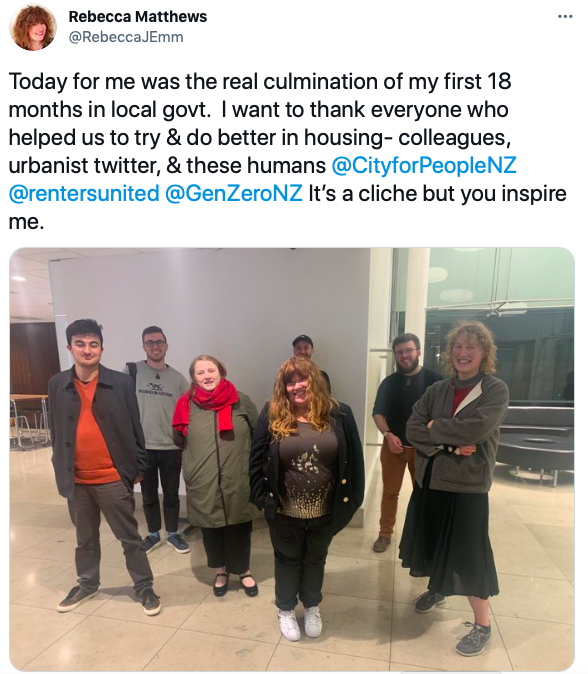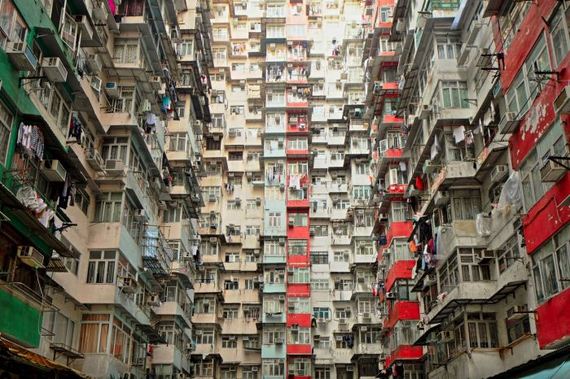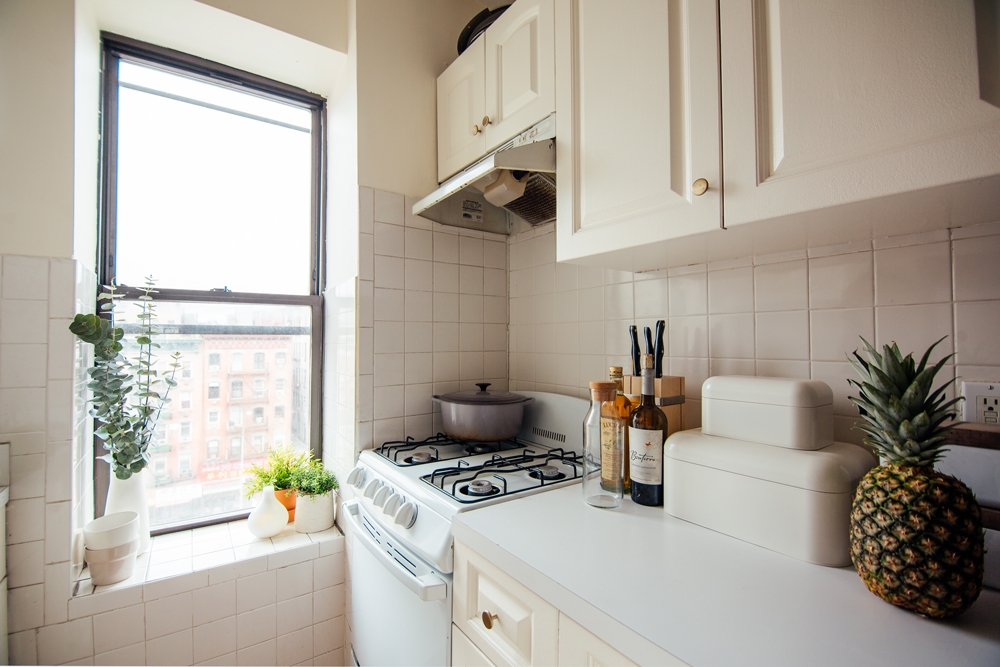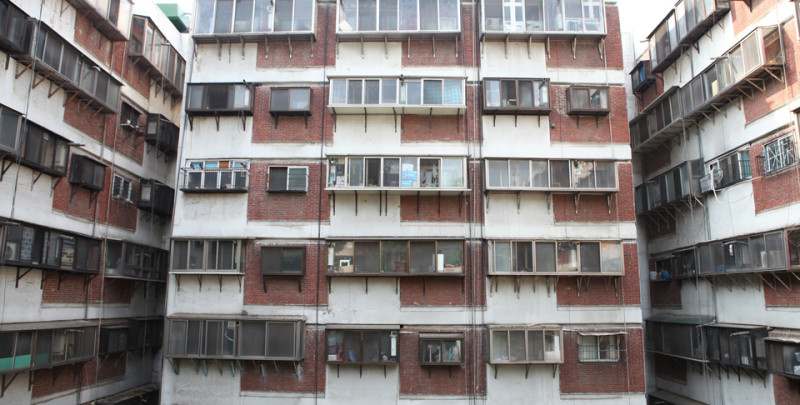“Art for Art’s sake – Money for God’s sake”. Or as we have it now, Growth for Growth’s sake. We now have a Council that has passed the Spatial Plan, in a decision that some have described being a battle over young vs old. Up to 80,000 more people will be able to live in our city, in a gradual process over the next 30+ years.
So we now have a Spatial Plan, one that moves from Draft to Full, albeit one that has adopted some, but not all, of the amendments. The youth group City for People proudly say “We Won” but at this stage, to be honest, we’re really not sure exactly what they have won. The proposal to have a completely unlimited height limit was not passed, which I think is a good thing and presumably on that one, City for People would say “We Lost”, but honestly: thank goodness that unlimited height limits have not been adopted. I watched about 3 hours of the ultimately 10 hour long meeting marathon (rumours that several Councillors died of exhaustion during the meeting are not confirmed) and I certainly lost the will to live while listening to some of the Councillor rantings.

I’m disappointed that the Council ultimately put the confusing 4a and 4b type housing heights back into the mix – it was confusing then, and then they changed it to make it less confusing, and then they changed it back again. Hey Council Officers: sort your shit out! Use some logical, plain English for these things. Having one zone being “Up to 6 Storeys”, and another being “Enable 6 Storeys” which actually means it could be less and it could be more – that’s just dumb. Dumb. Be consistent! Why not just give the actual range of storey height allowed? such as 1-2 storeys, 2-4 storeys, 3-6 storeys, 4-8 storeys? That’s how you do unambiguous storey heights Liam Hodgetts!
Is it really a battle of young vs old? Or is it more of a battle between those who believe in growth and those who do not? Our entire political, social, economic system relies on growth – which, we all know, either deep in our hearts, or sitting right up there on the surface, is completely untenable. Growth simply cannot go on forever. But the economic model wants it nonetheless. The best example of that lesson is the Chinese multi-decade experiment with the One Child Policy – which slowly worked, and then worked even more, and now that the whole population has gone into reverse (while India’s has not) then the Chinese government now has allowed not just two, but even three babies per couple. Population decline, or even stasis, means, in effect, economic collapse. Just ask Detroit – once the bustling centre of America’s Motortown, full of people, full of factories, full of cars – now devoid of life with only a tenth of its population in some areas. But a great place for photographers of urban ruins…. But I digress.

So exactly where we are and what any of this means is totally unknown at present. Exactly which areas of “Character” areas have been preserved, and which have not, are still a bit unclear. City for People tweeted:
“Huge win! The expanded colonial character precincts have been rolled back to the smaller areas in the draft plan. A big win for housing, our climate, and decolonising our city!”
All of which is, sadly, green-washed politicised bullshit. Won’t really have any effect on the climate in the foreseeable future, is nothing to do with decolonising our city, and its debatable whether or not it is any sort of “big win” for housing. Certainly it is not going to magically result in “Affordable Housing”. I’m not sure that anyone really knows how to suddenly create Affordable Housing, but allowing developers to demolish “colonial” era houses does not in any way mean that what replaces it will be “affordable”. Let’s break that phrase down a little, shall we? Say, perhaps, that a developer buys a house in Mount Victoria for a million dollars. Unaffordable for anyone who doesn’t already have a property to sell in exchange. Although it is very unlikely that the developer could do this: let’s pretend that the developer could now build 6 storeys of housing on top of the site (in reality, as Mount Vic houses are quite small, on very small sites, it would be more likely that the friendly developer would need to buy several adjoining houses).

- Start with $1 million, buy a small 100m2 house in Mt Vic on a 200m2 site.
- Demolish / remove house for $50,000
- Fees to Council and architects/engineers/planners/surveyors/geotech engineers $200,000
- Build 6 stories of new housing – let’s say 12 flats at 75m2 each. Two bedrooms possible.
- Each flat is going to cost a minimum of $3500/m2 each – probably way more.
- That works out as construction cost of a minimum of $262,500 each.
- You’ll need a core of, say, 30m2 per floor as well, at the same build rate.
- All up, $5,030,000 including purchase price
- Allow a 20% margin for profit, ($1,006,000) which is very tight for a developer
- Total development cost $6,036,000. And then add GST (another $905,400)
- Which is $6,941,400. Costs are getting up there. Let’s add in some costs for borrowing and call it $7,000,000 total. Again, this will probably be way more. But this makes for:
- or 12 units at $583,333. Which sounds almost vaguely affordable. Except that:
- A repayment ratio of 3.5 times your salary for an affordable repayment means you should be on a salary of $167,000 pa.
- And that’s just not happening now, is it?
- How many young people are earning 167k per year? None. But yes, it could work for a couple, ie 2 x people earning $85k each. How many young people do you know who are earning $85k per year? Not many, if any?
- And all of this relies on a construction cost of $3500/m2 which is highly unlikely.
- More likely to be about $6000/m2 for multi-storey construction. Which makes the whole thing waaaaay more unaffordable.
So, what now? That’s the problem – that the youth wing of Council have not done the maths, or more likely, have no idea of the process or the costs. Some people would say: “That’s easy to solve. Build cheaper! Build smaller! Less colonial features! Use bland design, not quality design! Maybe it is time to get Ugly! Don’t pay GST on new builds or fresh vegetables!” It’s true – we could build units for 30m2 each, instead of 75m2. That’s a bed-sit or studio, rather than a 2-bed apartment, but in theory you could still have 2 people in there. Building in a less costly manner is going to be tricky – unless you import quick and shitty modules from China. And some people are already doing that. Using a lower level of construction quality is unlikely to achieve the “warm, dry, safe” homes that Generation Zero have been madly advocating for.

Your thoughts and comments?





That financial breakdown is super handy. You could also break down the environmental and social costs of demo and rebuild e.g. loss of embodied energy of existing building, waste to landfill, energy used for materials, transport etc in new build, effects on social cohesion/community resilience when Mt Vic residents, including those who rent flats in character buildings, move out.
We’re not going to build our way out of the climate crisis and there need to be incentives for retrofit and adaptive reuse. The maxims of reduce, reuse and recycle apply as much to the construction industry as any other industry – perhaps more as they create most of our waste. Europe is years ahead of us on this front.
Thanks Amanda – yes, it’s just a quick and dirty breakdown, without any of those more nuanced aspects you speak of. But if you can’t make the basic numbers stack up on a project, then it’s no use trying to push it further. Adaptive reuse is an interesting one – and one they’ve been doing to some extent in Auckland. On the Orakei development old state houses were getting jacked up off their foundations and driven north to iwi further up the motu – giving a new home to the folk up north, and clearing land for the massive redevelopment they’re planning. Going to be a lot harder to extricate houses in one piece off the side of Mt Vic though !
And your rebuild is dependent on the pipe capacity being there. And that’s not cheap: they spent about 3 months replacing (not upgrading) the sewer and wastewater pipes in about a third of Queen Street recently so you can see the cost and disruption if you built up over the whole area. And that cost goes on the price of the development.
I think you’re off on the income there Nemo, I know quite a few people on over $85k
If this chart is correct
https://figure.nz/chart/6qPO9EveIqLz0bFO
average household income in Wgtn is around 100k
Now I don’t hang out with a lot of nurses teachers and cops but I know plenty who are North of that figure
This planning change opens up a door for people who are neighbours that wish to band together and develop themselves, maybe linking up their back yards together
Agree with Amanda re the waste thing – there’s a new build up in Otaki that just closed tender and the contract calls for no rubbish from the site at all, could be interesting
“…the contract calls for no rubbish from the site at all.”
Tell him he’s dreaming. No rubbish?
Are they going to dig a pit and bury it on site, perhaps?
All that will happen is that things will get cut and sized off site, the same waste will still happen, there will just be an intermediate step with more transport involved,
But the owner will get to bask in the self satisfying glow of their “zero waste” build,
Its like thinking that closing down cement works, Aluminium smelters and Methanol plants in NZ is helping to reduce emissions, when we still continue to consume those products, which now have to be imported from factories which operate on much more carbon intensive power grids…
out of sight, out of mind….
But “average household income” presumably means the average of everyone who lives there – ie probably two incomes if it is a couple. The average income for NZ is currently about $56,000 pa from memory.
So, yes, totally affordable if you earn significantly more than the average salary. But for young people who are starting out – I’m just trying to point out that the first step on the ladder is always going to be a tricky one.
Of course, I’m talking about real people in real jobs – architects, project managers, engineers, excellent builders etc. Not huge salaries for them. However, there are other professions, apparently, where massive starting salaries are possible, for a graduate straight out of university….
https://www.stuff.co.nz/business/125488176/it-students-are-being-offered-up-to-215000-straight-out-of-university
“Kiwi computer science students in their final year at university are being lured across the Tasman with pay offers as high as NZ$215,000, as global competition for top grads heats up.
The Sydney arm of Dutch financial technology company Optiver turned the heads of students when it posted an advertisement on an Auckland University jobs board for graduate software developers with that starting pay.
Its jobs come with other benefits, including a flat management structure, a casual dress code, “chef-cooked” breakfasts and lunches, and weekly massages for all employees.”
Holy flying IT graduate Batman! I’d be on the first plane out of here as well !!
WCC listed 140k as the average household income in 2019
Again: household income is from 2 people usually, not just one individual salary. And Wellington usually has the highest household income in the country. DINK due to lots of civil servants (if they are still called that).
“I’m not sure that anyone really knows how to suddenly create Affordable Housing. . . ”
Out of idle curiosity, isn’t that what the much-lauded, much-despised State Housing did, back last century?
Sort of. The thing about State Housing was that up until then, it was very difficult to get hold of money. Very different situation now, where every night on TV they are pushing the availability of cheap and easy money on people. Money has never been cheaper than today – nor more readily available. Back then – way back in the 1930s and all the way through to the 1950s, the only way a person could get a loan, was from the State Advances Corporation. As far as I understand, loaning money for a house was not a thing that banks would really do back then for the “average” punter. It also had the effect of keeping house prices stable – the State Advances Corporation would never do something so silly as loan you more than a house was worth – my grandfather worked for SAC and so he would not allow people to pay more than it was worth. Wish we had that system around now! “A home in Berhampore sir? On a 250m2 section? That’s nearly worthless – no one should pay more than $100,000 for something like that.” And so that’s all that anyone could offer for it.
State Houses were different, obviously, as they were not sold, but assigned to worthy families. We had low immigration, as in those days many kiwi men had gone off to war, many had dies, and many simply did not come back. NZ was seen as being much the same as Mars is now – an impossible place to return from. A 6 week boat trip that cost the earth. No importing of labourers to do the hard work – kiwis back then were hard workers and we did our own manual labour. History is a different country…
In 1950, 15 years after State houses started being built, NZ had 45,000 people on it’s state waiting list https://en.wikipedia.org/wiki/State_housing#1950%E2%80%931990
So, proportionately then, that 45,000 total on the waiting list must have been about the same proportion as now – around 2% ish. I wonder if the papers were full of notices about a “housing crisis” ? We’re there people sleeping in the streets? I think not ?
The reasons for the long state housing waiting list were different in 1950 than they are now. The first was that construction of housing largely stopped during WW2, furthering an already chronic shortage of housing originating in the 1930s Depression. The second was that the allocation criteria for state housing was more liberal and middle class people could become tenants. A third reason was that state housing had raised the standard of NZ housing and were seen as desirable dwellings to live in. All these factors combined to inflate the waiting list and led to the 1950s National government to begin the process of making state housing a residual provision for the poor only.
If there is one take away from the history of housing in Aotearoa it is that the state is best equiped to deliver good quality and affordable housing.
As late as the mid 1960s people lived in state Transit Camps – relocatable military barracks left over from WWII – waiting for a state house. Not exactly motel accommodation, but arguably just as grim.
You’ve forgotten the development contributions of many $$$.
And you’ll be paying for an new $100,000 electricity transformer too, assuming there’s 11kV cables in the street – or you’ll be trenching back to god-knows-where. Not that your architect will think about that, for some reason few seem to.
And the construction company will likely collapse partway through construction.
Man, who’d be a developer.
Chico, you’re absolutely right – there are a whole lot of additional costs that need to be borne by the developer – so the overall question then remains: to make new buildings as “affordable housing”, what needs to be done?
Do you think the character areas were the most significant change adopted? In terms of hectares zoned for 6 stories I’d say absolutely not. And many of the other places upzoned have larger average lot sizes.
But that’s 12 new homes that people with a little more money can buy, taking them out of the bidding of 12 other homes, which hopefully gives those with a little less money a bit more of a shot.
There’s a stunning assumption built into the calculation: that the developer will limit the price of the apartment to “reasonable costs”. That figure is simply the minimum it would take to make building financially viable. The developer will seek to sell at the “market price”. And as any new apartment in Mt Victoria goes for something in excess of 800k, that is the minimum they will be pricing to. Anyone who seriously believes that developers are going to race to build in such numbers that they will drive the market price down by hundreds of thousands of dollars needs to show us that the swathes of land in prime locations already zoned for apartments and remains undeveloped somehow just didn’t do it for developers and everything is now so different.
+1. Totally agree on that.
I’ve got a theory that a lot of this property price rise around the regions is driven by spikes in (mainly Auckland) metro prices twinned with covid
I think that a lot of homeowners sitting in houses that they paid less than half a mill for are looking at their projected retirement dates and are, say, in their mid to late 50s and saying “fuck it, lets sell for 1.3 and buy someplace in (Gisborne/Waikanae/Whanganui/Waimakariri) for 700k and that’s our retirement”
Lots of them can still work remotely in a covid world so the country is their oyster
A guy in my gunclub just sold up for a better property in North Canterbury (4 acre block for a 10 acre block) and got 300k up on the deal. Why not?
The 3 D’s of property- Death Divorce and Desire
Is anyone studying this? Where’s that Shamubeel Eaqub now that we need him most? Any data or anecdote out there?
I’m sure you’re right. The amount of wealth (on paper) being generated by Auckland property prices is staggering – one of my friends in the UK sent me a Guardian link this morning with the story of the house in Grey Lynn that sold for over $2million, and didn’t even have a toilet (just rotting walls inside). All around the world house prices are going up, but Auckland in particular is being particularly silly.
Having lived through at least 2 massive price crashes before, I’m not particularly looking forward to another period of stagnation – but heck, we really need a property price crash now to bring things under control. An overnight 30% drop in property prices would bring a lot of the country to its senses – also to its knees.
I’d be very relaxed about a 30% price drop but I don’t see it happening. I’ve spoken to people who think that the earnings to deposit ratio can’t sustain this froth and bubble much longer but for every person who puts their best bid in there is someone else who just came back from overseas flush with cash and going that extra 5-10 percent further into silly money territory
A house in Masterton last week with a 1400 sq m section sold sight unseen to an out of town developer who will probably whack townhouses on it – they will most likely have a design that has met approval before that will be only slightly tweaked and made to fit the space
I worked on these nearly a year back
https://www.trademe.co.nz/a/property/residential/sale/wellington/wellington/newtown/listing/2613823642?bof=q7Hh2nxo
and apparently the developers have a back-order for these things of 50mill
Get a site, same design, build em rinse and repeat
Sorry if this is depressing for an urban design blog but it’s one of the market forces around us
Also I don’t think that this govt is getting a handle on the house price rise (this is not a partisan comment, National were wilfully blind on the matter and as much good as a one-legged man at an arse-kicking party too)
I see Labour’s soft-nationalisation of the 3 waters as an attempt to take away a major cost from councils but I can’t see much being done on the positive side – bulk funding for new housing developments from central govt in return for x percentage affordable houses, you know the deal
I hope that the millenials find an app that gets them all saving together for houses – pick an area, make the minimum payment deposit or save and watch yourself progress into house share ownership. Keep making mortgage payments and then graduate out with enough for your own deposit
Designing a contract for this kind of deal is not difficult and there is certainly space in the market for someone to underwrite this
Otherwise we are chugging along on out two-track society, the asset owners and the youth, calling us up once a fortnight in the hope that we have snuffed it and left them a house..